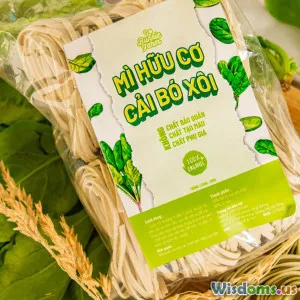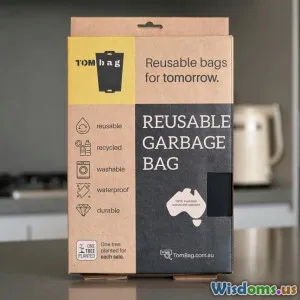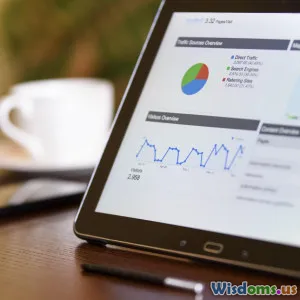
Why Eco Friendly Packaging is Dominating New Food Markets
9 min read Explore why eco friendly packaging leads food markets, blending sustainability, consumer demand, and innovation. (0 Reviews)
Why Eco Friendly Packaging is Dominating New Food Markets
In an era marked by climate anxiety and rising demands for sustainability, a quiet revolution is underway—transforming the way food reaches consumers' hands. Eco friendly packaging has emerged as the hero of new food markets, revolutionizing not just how products are wrapped but reinventing the entire food ecosystem. But why has this sustainable packaging become so dominant? The answer lies in a potent mix of consumer values, regulatory shifts, and innovations driving environmental consciousness to the forefront.
Introduction: Wrapping Tomorrow’s Food Today
Packaging is often overlooked, perceived as merely functional; however, it carries immense significance in food marketing, preservation, and sustainability. Today’s consumers are more aware of the environmental footprint of their purchases than ever before. According to a 2023 survey by NielsenIQ, 73% of consumers were willing to pay more for brands committing to sustainable packaging.
As climate change urgency grows and waste accumulation overwhelms global landfills, food companies and startups entering new markets face increased pressure to adopt eco friendly packaging solutions. This paradigm shift isn’t just regulatory—it reverberates deeply within consumer psychology and market dynamics. This article unpacks why eco friendly packaging is becoming the dominant force in emerging food markets.
Environmental Impact: Fighting Food Waste and Plastic Pollution
Reducing Plastic Pollution
Globally, food packaging accounts for a significant share of plastic waste. Approximately 40% of all plastic production is for packaging, much of which is discarded after single use. The environmental toll is staggering—marine life entanglement, microplastic contamination, and greenhouse gas emissions from production and degradation.
Eco friendly packaging introduces biodegradable materials like plant starch, cellulose, and mushroom-based packaging that decompose naturally without polluting ecosystems. For example, Ecovative Design, a company creating mushroom-based packaging alternatives, has partnered with leading food brands to replace plastics with compostable solutions.
Combating Food Waste
Food spoilage waste contributes massively to environmental damage. Innovative eco friendly packaging materials now offer improved barrier properties, extended freshness, and reduced preservative need—thereby lowering food waste rates. Research published in Food Packaging and Shelf Life (2022) highlights bio-based films infused with antimicrobial agents increased shelf life up to 40%.
Startups in new food markets such as Africa and Southeast Asia utilize these technologies to reduce spoilage along supply chains lacking cold storage infrastructure, ultimately decreasing carbon footprints.
Consumer Demand: The Green Wallet Speaks
Millennials and Gen Z Leading the Charge
Younger consumers fuel the demand for sustainability. A 2024 Accenture report states 64% of Gen Z actively seek brands with sustainable credentials, including packaging.
Brands in burgeoning food markets are tailoring eco friendly packaging to appeal to these demographics who value environmental transparency. For example, Beyond Meat employs recyclable and compostable materials prominently labeled with sustainability information, which helped it skyrocket in rapidly growing alternative protein markets.
Transparency and Trust
Eco friendly packaging fosters trust through transparency regarding a product’s environmental impact. Packaging printed with QR codes linking to carbon footprint metrics or origin stories strengthens consumer-brand relationships.
Brands like Alter Eco, a chocolate maker championing ecological farming and zero-waste packaging, demonstrate how storytelling on sustainable packaging resonates deeply with conscious consumers.
Regulatory and Market Forces: Driving Systemic Change
Stringent Regulations Worldwide
Governments increasingly enforce packaging waste reduction policies. The European Union’s Single-Use Plastics Directive and U.S. state-level restrictions on plastic bags and Styrofoam containers push companies to innovate or face penalties.
Emerging food markets are often encouraged via trade incentives or subsidies for sustainable packaging solutions, accelerating adoption. For example, Brazil incentivizes bioplastics development to reduce Amazon deforestation ties with petrochemical packaging.
Corporate Environmental Responsibility
Major food corporations set ambitious green agendas, investing heavily in sustainable packaging to meet stakeholder requirements and future-proof against resource volatility.
Nestlé announced its commitment to making 100% of its packaging recyclable or reusable by 2025, spending $2 billion on R&D for eco friendly materials. Their proactive shift has ripple effects down supply chains in all market entrants.
Innovation Powering the Shift
Cutting-Edge Materials
Emerging materials define the next frontier. Innovations like seaweed-based films, edible packaging, and compostable multilayer films provide durability while remaining environmentally gentle.
Notpla, a UK startup, has popularized seaweed packaging that decomposes in weeks and is already adopted by beverage companies in Asian food markets.
Circular Economy and Upcycling
Eco friendly packaging is also evolving from a disposal mindset to a circular one—focusing on reusability and materials reclaimed from post-consumer waste.
Companies like Loop implement reusable packaging loops for snacks and meals, incentive programs encouraging consumers to return containers for reuse.
Challenges and Considerations
Cost Implications
Eco friendly packaging can present higher upfront costs due to new materials or processes, which can be challenging for fledgling businesses in emerging markets.
Nevertheless, declining costs, scaling production, and government incentives are reducing this barrier. Moreover, brand differentiation and premium pricing for sustainability often offset initial investments.
Consumer Education
Ensuring consumer understanding about recycling, composting, or reusing eco friendly packaging remains crucial. Without proper disposal, sustainability benefits could be lost.
Brands should integrate clear instructions on packaging and invest in campaigns to raise awareness.
Conclusion: A Sustainable Future Wrapped in Innovation
The domination of eco friendly packaging in new food markets is neither a fleeting trend nor a regulatory burden—it's a resilient shift reflecting global imperatives and shifting consumer priorities. Driven by the urgent need to curb environmental impact, powered by breakthrough innovations, and propelled by engaged consumers, eco friendly packaging stands at the forefront of an evolving industry ethos.
In embracing eco friendly packaging, food brands not only reduce their ecological footprints but also weave compelling stories of sustainability that resonate deeply with modern shoppers. This symbiosis propels growth, inspires loyalty, and shapes industry narratives for decades ahead.
As conscientious consumers and responsible companies advance hand-in-hand, the future of food packaging shines greener and brighter—proving that sustainable choices can indeed dominate new food markets worldwide.
References and Further Reading:
- NielsenIQ (2023). Global Survey on Sustainable Packaging Trends.
- Food Packaging and Shelf Life (2022). Bio-based Antimicrobial Packaging Films.
- Accenture Strategy (2024). The Gen Z Sustainability Imperative.
- European Parliament (2019). Single-Use Plastics Directive.
- Nestlé Corporate Sustainability Reports (2022–2023).
- Notpla Official Website and Case Studies.
- Ecovative Design Company Reports.
Author's Note: This article provides insights that can help both entrepreneurs and consumers recognize the transformative potential of eco friendly packaging within rapidly evolving food markets worldwide. By understanding the drivers and challenges behind this phenomenon, all stakeholders can contribute meaningfully toward a healthier planet.
Rate the Post
User Reviews
Popular Posts
















